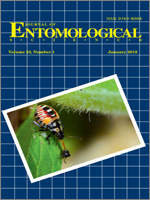The susceptibility of clearwing moth Paranthrene diaphana (Dalla Torre & Strand) last-instar larvae to the entomopathogenic nematodes Steinernema feltiae (Filipjev), Steinernema carpocapsae (Weiser), and Heterorhabditis bacteriophora (Poinar) was determined in laboratory assays. Larval mortality was assessed at 0, 6, 12, 24, 48, and 72 h after exposure of the larvae to six concentrations (0, 50, 100, 200, 400, and 800) of infective juveniles (IJs) per bioassay arena. The median lethal concentration (LC50) for each nematode species was 35.97 IJ/ml for S. feltiae, 44.0 IJ/ml for S. carpocapsae, and 104.5 IJ/ml for H. bacteriophora. The median lethal time (LT50) for each nematode species at the concentration of 100 IJ/ml was 43.94 h for S. feltiae, 60.88 h for S. carpocapsae, and 82.3 h for H. bacteriophora. Based on these and other results, we conclude that research should be expanded on the prospects for using entomopathogenic nematodes, especially S. feltiae, in managing P. diaphana.
How to translate text using browser tools
1 January 2018
Laboratory Assay of Entomopathogenic Nematodes Against Clearwing Moth (Lepidoptera: Sesiidae) Larvae1
Saeed Azarnia,
Habib Abbasipour,
Ayatollah Saeedizadeh,
Alireza Askarianzadeh
ACCESS THE FULL ARTICLE
biological control
entomopathogenic nematode
Heterorhabditis
Paranthrene diaphana
Steinernema





